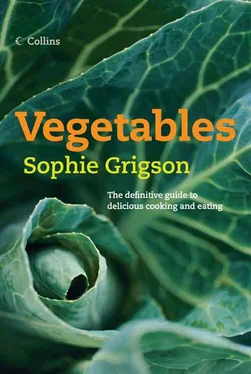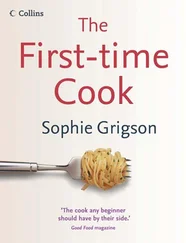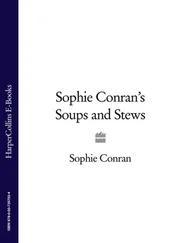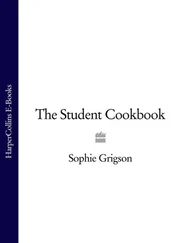Choosing the right potato for the job in hand is important, although all rules are made to be broken. Just get to know them first, before you attempt flagrant breaches. In other words use chunky maincrop potatoes for: baking, mashing, boiling, roasting, deep-frying, sautéing, adding to doughs to lighten them (e.g. in potato bread, or potato scones), gratins and so on. Save new potatoes for: boiling, salads, sautéing, gratins, and roasting whole. Yes, there are overlaps, but the results will differ with the potato variety used.
I’ve had to concede, reluctantly, that my mother was right when she insisted that one should always buy dirty potatoes. A thin jacket of dried-on muck does indeed seem to preserve flavour to some extent. Not critical, but a bonus if you are prepared to spend a couple of extra minutes at the sink scrubbing them clean. Dirt or no dirt, glance over potatoes as you pick them out to ensure that they are free from bruised machinery gashes, mouldering patches (a sign of poor storage), sprouting shoots, and above all patches of green. That charming green coloration tells you that the potatoes have been exposed to light for too long, thus developing poisonous toxins. Not a good thing.
Maincrop and salad potatoes can be kept for some time in the right conditions (a dark, cool, dry place) but new potatoes have a short shelf life. Eat them within a few days of purchase to enjoy them at their best. Don’t leave either sort of potato in a closed plastic bag for any longer than is necessary – moisture will gather in its folds, and sooner or later your potatoes will start to rot.
Don’t keep potatoes in the fridge, or at least not for more than a day or two. In the icy claustrophobic atmosphere, the starches in the potato mutate into sugars, which, while not cataclysmic, is not really appropriate for most potato dishes.
With their light flavour, and engaging textures, there is no end to the ways in which one can use potatoes. Potato recipes abound right around the globe, in each region gilding the basic lily with characteristic local ingredients to mould them into the local cuisine. They are just so darned versatile, a word that I loathe, but which is absolutely right in this context. For this reason I’m not going to list a chapter of ideas for how to embellish potatoes. Once you can make silky mash, bake jacket potatoes, turn out perfect crisp roast potatoes, sauté diced potatoes, and conjure up a mean potato salad, you will have mastered all the essential techniques you need to create almost any potato dish ever invented. The rest, frankly, is just a question of exercising your curiosity and imagination.
The marvellous yet confusing thing about making mashed potatoes is that there is no absolute one-and-only ideal recipe. I happen to think that perfect mashed potatoes are as smooth as silk, not quite runny, but nowhere near stiff, with plenty of nutmeg and butter to boot. You may disagree. Once you are in control of the basics, however, you can adjust method, ingredients and quantities endlessly to suit your own credo.
My mum always baked potatoes for mash and so do I – the flesh is drier and has a more distinct flavour. Microwaved potatoes are good too. Boiling comes next in line, as long as you use evenly sized potatoes and boil them in their skins. As soon as they are drained, cover with a clean tea-towel and leave to steam-dry for 5–10 minutes before peeling off the skins. Don’t peel potatoes and cut into chunks before boiling – they will just get waterlogged and lose much of their taste to the water, producing a dull, flat-tasting mash.
Good varieties for mashing are King Edward, Maris Piper, Golden Wonder, and Kerr’s Pink (my favourite), amongst others.
Mashed potatoes are a perfect receptor for all kinds of extra, zippy ingredients – try stirring in some coarse-grain mustard or a spoonful of creamed horseradish. The Irish love to add chopped spring onions softened in butter or cooked cabbage, or you could go ultra modern and mix in roughly chopped rocket leaves and the finely grated zest of a lemon.
Serves 4
1kg (21/4 lb) floury maincrop potatoes
115 g (4oz) butter, at room temperature
150–300ml (5–10floz) hot milk, or a mixture of milk and cream
salt and freshly grated nutmeg
Either bake or boil the potatoes in their skins (see above). Halve baked potatoes while still warm and scoop their flesh out into a bowl. Save skins for making crisp-roast potato skins (see page 75). Peel boiled potatoes while still warm and place in a bowl. Add the butter.
Now the mashing itself. For a really smooth mash use one of the following methods:
a) push the potato little by little through a potato ricer
b) rub the potato through a vegetable mill (mouli-légumes)
c) mash roughly with a fork, then whisk with a hand-held electric whisk until light and fluffy
d) mash roughly with a fork, then rub through a sieve.
Scrape the puréed potato into a saucepan and place over a gentle heat. Add plenty of seasoning and about a third of the hot milk (or milk and cream). Beat hard with a wooden spoon, gradually adding more milk until the mash hits the kind of consistency that sets your mouth watering. Taste and adjust seasoning, and serve.
Chop 1 onion and fry in a little butter or oil until golden brown. Cover 10 leaves of fresh sage with boiling water (to release more flavour). Drain immediately, dry the leaves and chop roughly. Stir sage and onions into a bowl of hot mash made as above.
Perfect roast potatoes with a crackling crisp crust masking a melting, fluffy interior are rarer than they should be. The method is not hard, but it requires some forethought. The potatoes must be par-cooked in advance, then roughed up in order to develop that irresistible golden brown, crusty exterior.
If you are cooking a roast, don’t tuck the potatoes around the meat, but roast them in a separate tin, large enough to spread the potatoes out in an even single layer, not jam-packed in tightly.
The best fats to use are melted lard or dripping (without the jelly), olive oil or sunflower oil or, best of all, goose fat (available in cans and jars). I prefer to use either Cara potatoes, which have a smooth texture, or end-of-season large new potatoes, but for a fluffier interior head for the old faithfuls – King Edward, Maris Piper, Désirée, Estima and their kin.
Serves 4
1.3 kg (3 lb) large potatoes
6 tablespoons goose fat, lard, olive oil or sunflower oil
salt
Preheat the oven to 200°C/400°F/Gas 6.
Peel the potatoes and cut into medium-sized chunks – say about 5 cm (2 in) across. Cook in boiling salted water until three-quarters cooked – around 5–6 minutes. Drain thoroughly. Use a fork to scratch criss-cross lines all over the surfaces of each chunk of potato, roughing up the exterior so that it crisps perfectly.
Put the fat in a large roasting tin and slide into the oven. Heat through for 5–8 minutes. Quickly take the tin out and add the potatoes. Turn so that they are all coated in hot fat. Return immediately to the oven. Roast for about 40–50 minutes, turning the potatoes after the first 25 minutes and then again once or twice more, until they are browned and crisp all over.
Serve straightaway.
Who doesn’t love chips? And the best chips of all are those you make at home, from scratch. Frying up a batch of real chips is not something you will want to do every day, but as an occasional treat they’re worth every moment of standing over a hot pan.
Читать дальше












